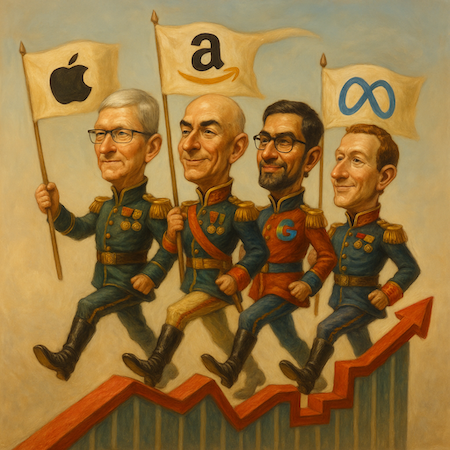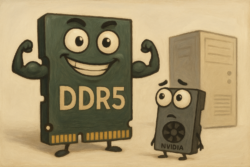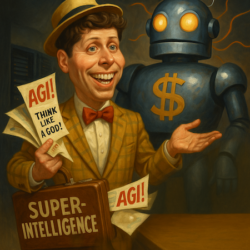 Richard Russell, the legendary author of The Dow Theory Letters, frequently used versions of the saying that, “when generals march, the troops follow.”
Richard Russell, the legendary author of The Dow Theory Letters, frequently used versions of the saying that, “when generals march, the troops follow.”
By that, he meant when the dominating stocks in the market charge, in doing so, they drag an entire batch of smaller “troops” along for the ride.
And boy, are the generals marching now!
Apple. Amazon. Google. Meta. Four of the biggest companies in the world, collectively worth more than the GDP of most countries, all dropped earnings this week.
And once again, the story is the same: stronger revenues, fatter margins, and a whole lot of humble pie for anyone betting against the AI boom.
So, just how hard and fast are the generals marching?
Up, up, up… and down?
Apple reported record quarterly revenue of $102.5 billion, up 8% year-on-year, driven by relentless demand for the new iPhones and early hints of more complete AI integration in its next-gen devices.
The stock tanked briefly (weirdly) and then rebounded around 8% to peak in post-market trading. Wild movement, but clearly a lot of life and AI future ahead of the consumer tech stalwart.
Google then dropped eye watering earnings, too.
They posted their first-ever $100 billion quarter, having doubled revenue inside of five years. AI revenue for Google Cloud grew at an astonishing speed, Gemini now has over 650 million active users and Google too is driven by AI demand.
Also, don’t forget about their other crown jewel, YouTube. It remains the number one streaming platform in terms of watch time in the world and even set a new world record for the highest number of concurrent streaming views for a live stream of 19 million.
As you’d expect, their stock price also pumped almost 9% off the back of their announcement.
Amazon, meanwhile, said “hold my beer” and proceeded to annihilate earnings and the market’s expectations.
Revenue surged to $180.2 billion, and net income ripped higher year-on-year to $21.2 billion
But the story with Amazon was all about AWS, its crown jewel, growing faster than any analyst expected.
Andy Jassy, President and CEO, said,
“AWS is growing at a pace we haven’t seen since 2022, re-accelerating to 20.2% YoY. We continue to see strong demand in AI and core infrastructure, and we’ve been focused on accelerating capacity – adding more than 3.8 gigawatts in the past 12 months.”
The chatter about AI-driven cloud demand wasn’t hype after all. Post-market, the stock exploded over 12% and it’s set for one of the most monstrous rises in market cap in a single day we’ve ever seen from a company.
And Meta?
Zuckerberg’s empire blew past expectations with $51 billion in revenue, up 26%, and an 18% rise in operating income.
But… they had a 788% rise in provisions for income tax, which took their earnings per share (EPS) down to just $1.05 down 84% from the year prior.
As Meta explained,
Excluding this one-time tax charge, our third quarter 2025:
-
- Effective tax rate would have decreased by 73 percentage points to 14%, compared to the reported effective tax rate of 87%.
- Net income would have increased by $15.93 billion to $18.64 billion, compared to the reported net income of $2.71 billion.
- Diluted EPS would have increased by $6.20 to $7.25, compared to the reported diluted EPS of $1.05.
In short, they killed it too. But the market killed their stock price, down 11% for the day.
Buy or look elsewhere?
Here’s the thing, the market was braced for disappointment and for overblown AI costs eroding profits and earnings. Analysts fretted that maybe AI’s growth was “slowing,” that enterprise spending might cool, that the easy money had been made, and these massive costs would weigh too heavily.
Well, bollocks to that. Nothing is slowing the AI boom down.
These companies are pouring billions into AI infrastructure, servers, GPUs, datacentres, and power, and the returns are already compounding. Every dollar spent on computing is turning into two, three, four dollars of productivity. Every generative model creates new demand for cloud capacity, chips, and the energy to fuel it all.
In other words, this boom has legs.
And yes, they’re the generals marching the S&P 500 higher, but as mentioned earlier, they don’t rise alone.
When Amazon’s AWS surges, so does the next tier of cloud providers. When Google’s AI workloads expand, it spills into Pure Storage, Marvell, and Micron. When Meta’s AI ad engines hum, the semiconductor, networking, and optics play ride the wave. Even the nuclear energy sector gets a decent lift.
And don’t sleep on the next generation of compute. Extropic, Groq, Cerebras are just a couple of (private) names to keep tabs on.
Whether you’re holding the Magnificent 7, the neocloud providers, or the next generation of energy plays, this is one of the most exciting investment environments we’ve seen in decades.
Yes, valuations are high. Yes, the bears will forever say it’s a bubble. But when you have trillion-dollar companies reporting double-digit growth in a slowing world, you don’t fight the trend you ride it.
We’re living through a once-in-a-generation transformation of the global economy. AI, energy, quantum, robotics all converging at once. And it’s all happening under a US government that wants markets to run hot.
The best way to finish off today’s essay I think is with a quote from Richard Russell speaking of the post 2008 bull market.
I’d have to say that this is a market that has had every opportunity of going down, but it’s a market that has no intention of heading south….It’s the oldest story on Wall Street — when a market refuses to go down, it takes the other direction — and it goes up
And that is exactly what this market is doing too.
Until next time,

Sam Volkering
Contributing Editor, Investor’s Daily
P.S. The AI boom isn’t losing steam, it’s gathering pace. The “generals” may be leading the charge, but the next wave of opportunity lies with the companies being pulled along behind them. Our analysts have just released a briefing showing where that momentum could go next — and which stocks stand to benefit most.



